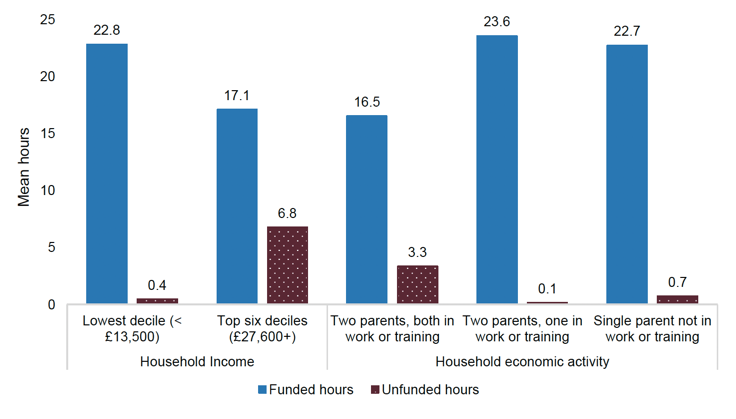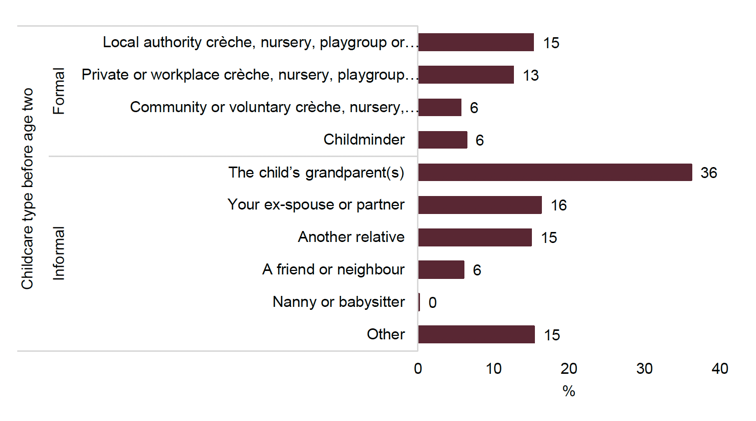Scottish Study of Early Learning and Childcare: phase 4 report
This report outlines findings from the 4th phase of the Scottish Study of Early Learning and Childcare (SSELC), focusing on two-year-olds who are accessing funded ELC. The SSELC forms a major part of the strategy for the evaluation of the expansion of funded early learning and childcare in Scotland.
3. Use of ELC
Information about ELC received from the primary setting was collected in both the keyworker and parent questionnaires. This included the number of hours the child attended the setting, and how many hours were paid for / how many were funded. Data from both sources are presented here.
Parents were also asked about their use of additional childcare, whether that be other formal ELC (such as private nurseries) or informal childcare from family, friends or babysitters. Findings from these questions are also presented here, along with data on the types of childcare used before the participating child was aged two, activities they, as parents, had done at the funded ELC setting, how accessible the setting was for them, and what they thought the main advantages/disadvantages were to having a child in ELC. All figures in this chapter have been weighted.
3.1 Formal ELC provision
Data from the keyworker questionnaire show that the mean total number of weekly hours spent at the participating setting by "Eligible 2s" was 23.3.[17] A third (33%) of children usually attended for less than 22 hours a week, and hence did not receive their full entitlement of funded ELC from the setting.[18] Table 3.1 shows the full breakdown for weekly (banded) hours attended at the setting.
% |
|
|---|---|
<16 hours |
13 |
16 to <22 hours |
20 |
22 to <25 hours |
22 |
25 to <28 hours |
10 |
28 to <32 hours |
32 |
32+ hours |
3 |
Unweighted base |
410 |
Base: All respondents (keyworker questionnaire, Phase 4, weighted)
The mean number of hours registered at a setting was 24.3 – 1 hour higher than the mean number of weekly hours typically attended. The mean number of weekly funded hours was 23.2 and the mean number of weekly unfunded hours was 1.1.
The remainder of this chapter presents data from the parent questionnaire.
Parents were asked about all formal ELC their child received weekly. Formal ELC included childminders, as well as private/local authority/community crèches, nurseries, playgroups or pre-schools. The mean weekly funded hours for all formal ELC was 21.6[19], while the mean figure for weekly unfunded hours was 1.3. As shown in Figure 3.1, there was a difference by household income. Those in the top six equivalised income deciles had, on average, a lower number of weekly funded hours (17.1) and a higher number of unfunded hours (6.8) than those in the lowest decile, where the figures were 22.8 and 0.4 respectively. Similarly, children from two parent-households with both parents in work, tended to receive fewer funded hours per week than children from other households.

Base: All respondents (parent questionnaire, Phase 4, weighted)
The full costs of ELC were funded for 89% of all those participating in Phase 4, while 11% of parents paid for additional unfunded hours.
3.2 Use of additional childcare
Around one in five (18%) parents reported that they used childcare on a regular basis from somewhere other than the participating setting. There were differences by household composition: one third (33%) of respondents living in two-parent households with both in work or training were using additional childcare. The equivalent figure for respondents in two-parent households with one in work or training was 4%.
Most parents (97%) did not use any additional formal ELC, while 3% used a childminder in addition to the formal ELC provided at the participating setting. The most common type of informal childcare used in addition to the care provided by the participating setting was the child's grandparents (13%) (Table 3.2).
% |
|
|---|---|
Grandparents |
13 |
Ex-spouse or partner |
4 |
Another relative |
1 |
Friend or neighbour |
0 |
Someone else |
0 |
No informal ELC |
84 |
Unweighted base |
328 |
Base: All respondents (parent questionnaire, Phase 4, weighted)
On average, across all parents at Phase 4, 2.6 hours of informal childcare were used. Of those parents who used informal childcare, the mean number of hours of informal childcare used was 18.3. The mean number of hours of informal childcare used was 7.7 hours where the household had two adults who were both in work or training, and zero where there were two adults and one was in work or training. The mean number of informal childcare hours used by those living in the most deprived SIMD quintile was 1.7, compared with 3.3 for those living in other areas.
The mean hours of all childcare used, both formal and informal and including the participating setting, was 24.9.
3.3 Previous use of childcare
Parents were asked what types of childcare their child had received before they were two years old. The most common provider of childcare received in this period was the child's grandparents (36%)

Base: All children (with keyworker observations, Phase 4, weighted)
3.4 Engagement with ELC setting
To measure levels of engagement with the ELC setting, parents were asked if they had participated in certain activities. Nine in ten (90%) parents had visited their child's room at the setting, and 44% had attended a parents' evening / information meeting. Around three in ten (32%) had attended another type of event besides a parent evening, and just under one in ten (9%) had helped or offered to help out in the setting, including on a trip or with an event. Only 7% of respondents to the parent questionnaire said they had not done any of activities mentioned.
A separate question asked about types of help and support offered to parents by settings. Table 3.3 shows the responses to this question. Around nine in ten (88%) parents had discussed their child's progress with their keyworker or another member of staff, and over half (54%) had stayed and played with their child. Around four in ten (38%) parents had talked to someone about how to support their child's learning at home, and the same proportion (38%) had received advice or information to support their child's speech, language and communication development. Smaller numbers had received other types of support for the family more generally. These are discussed in Chapter 6 in relation to the setting heads' questionnaire.
% |
|
|---|---|
Discussed child's progress with her/his keyworker or another member of staff |
88 |
Stayed and played with your child |
54 |
Talked to someone about how to support your child's learning at home |
38 |
Received advice or information to support your child's speech, language and communication development |
38 |
Received help with food or clothing |
12 |
Received wider family support, e.g. with relationships, housing or employability |
11 |
Received help with welfare rights or issues with benefits |
9 |
Learned a new skill such as cooking or parenting skills |
7 |
Received help with transport to and from the nursery |
3 |
None of these |
6 |
Unweighted base |
338 |
Base: All respondents (parent questionnaire, Phase 4, weighted)
Note: respondents were able to choose more than one response. As such, percentages will not total 100%.
For some of the activities asked about, engagement varied by area deprivation. Those in the most deprived areas (48%) were more likely than those living elsewhere (31%) to say they had talked to someone at the setting about how to support their child's learning at home. They were also more likely (49%) than others (31%) to say they had received advice or information to support their child's speech, language and communication development.
3.5 Travel to ELC
Table 3.4 shows that around two-thirds (64%) of respondents to the parent questionnaire lived within 10 minutes of the participating setting their child attended, and 32% had a travel time of 5 minutes or less to the setting.[20] Travel times of more than half an hour were more common in rural areas (7%) than urban ones (2%).
Total |
Urban |
Rural |
|
|---|---|---|---|
% |
% |
% |
|
0 to 5 minutes |
32 |
31 |
33 |
6 to 10 minutes |
32 |
33 |
29 |
11 to 15 minutes |
18 |
19 |
16 |
16 to 20 minutes |
8 |
10 |
6 |
21 to 30 minutes |
7 |
6 |
9 |
More than 30 minutes |
3 |
2 |
7 |
Unweighted base |
335 |
235 |
89 |
Base: All respondents (parent questionnaire, Phase 4, weighted)
3.6 Advantages and disadvantages of child being in ELC
Parents were asked to select what the main advantages (if any) were when children aged two attend "pre-school or nursery". Table 3.5 presents results from this question. In general, advantages for the child were selected more commonly than advantages for the parents. The most commonly selected advantage of having a two-year-old in ELC was that it is "good for children to interact and socialise with other children" (95%), closely followed by ELC being "good for children's independence/confidence" (92%) and that "children enjoy it" (87%).
Around three-quarters of parents (76%) said an advantage of a child being in ELC is that it "enables parent to work, study or train". No parents reported that there were no advantages to having a two-year-old in ELC.
% |
|
|---|---|
Good for children to interact and socialise with other children |
95 |
Good for children's independence / confidence |
92 |
Children enjoy it |
87 |
Helps children's educational development (including concentration, memory, language) |
84 |
Good for children to interact and socialise with other adults |
84 |
Prepares children for school |
80 |
Enables parent to work, study or train |
76 |
Good for children's behaviour |
75 |
Enables parent to do other things, e.g., shopping, exercise, free time |
64 |
Enables parent to care for others, e.g., other children, elderly parents |
44 |
No advantages |
- |
Unweighted base |
340 |
Base: All respondents (parent questionnaire, Phase 4, weighted)
Note: respondents were able to choose more than one response. As such, percentages will not total 100%.
Parents were also asked what they thought were the main disadvantages when children age two attend "pre-school or nursery". Around two-thirds (68%) reported that there were no disadvantages to a child that age being in ELC. Table 3.6 presents the full results from this question. Where a disadvantage was selected, the most commonly chosen were that ELC "hours are not long enough to allow time to work" (12%), that children "may be unhappy" (11%) and that "children pick up bad habits/behaviour" (10%).
% |
|
|---|---|
No disadvantages |
68 |
Nursery hours are not long enough to allow time to work |
12 |
Children may be unhappy |
11 |
Children pick up bad habits / behaviour |
10 |
Children don't get enough individual attention |
7 |
Nursery hours are not flexible enough |
6 |
Nursery may not be conveniently located |
5 |
Children too young to leave parents |
5 |
Children are less safe in nursery e.g. bullying / child protection / inadequate supervision |
2 |
Nursery too crowded |
2 |
Quality of care is not as good as at home |
1 |
Unweighted base |
329 |
Base: All respondents (parent questionnaire, Phase 4, weighted)
Note: respondents were able to choose more than one response. As such, percentages will not total 100%.
Contact
Email: socialresearch@gov.scot
There is a problem
Thanks for your feedback